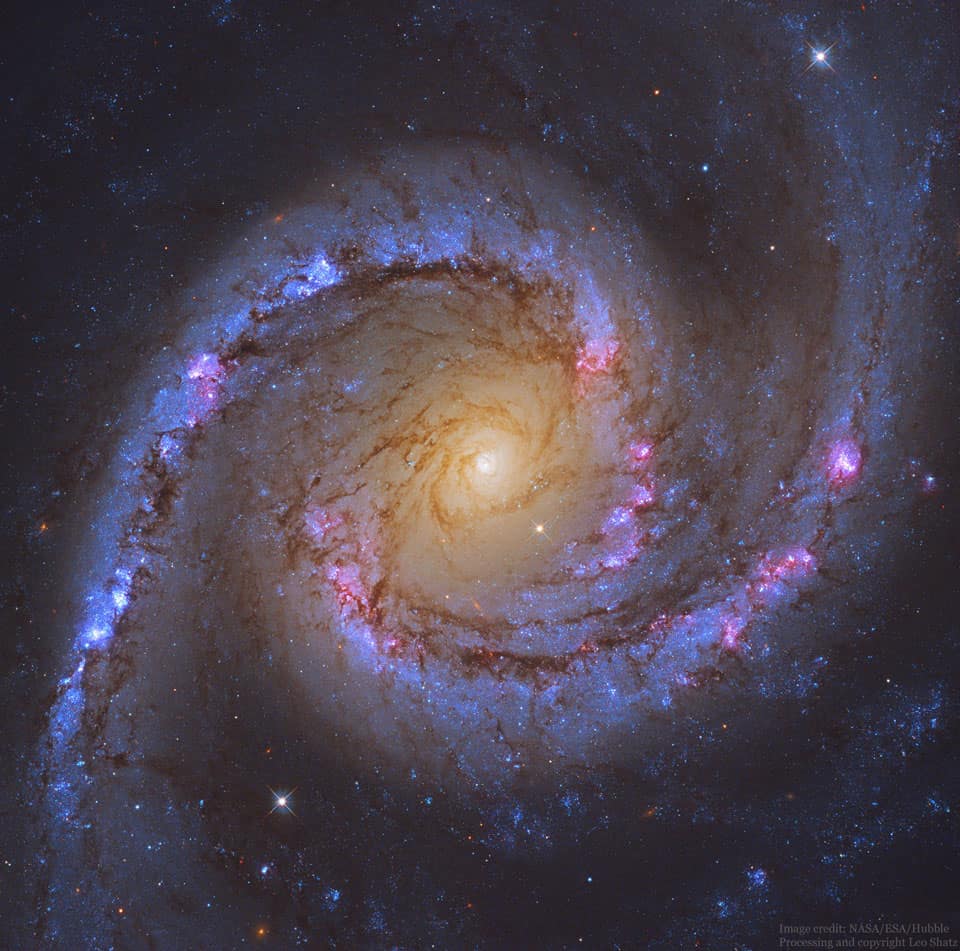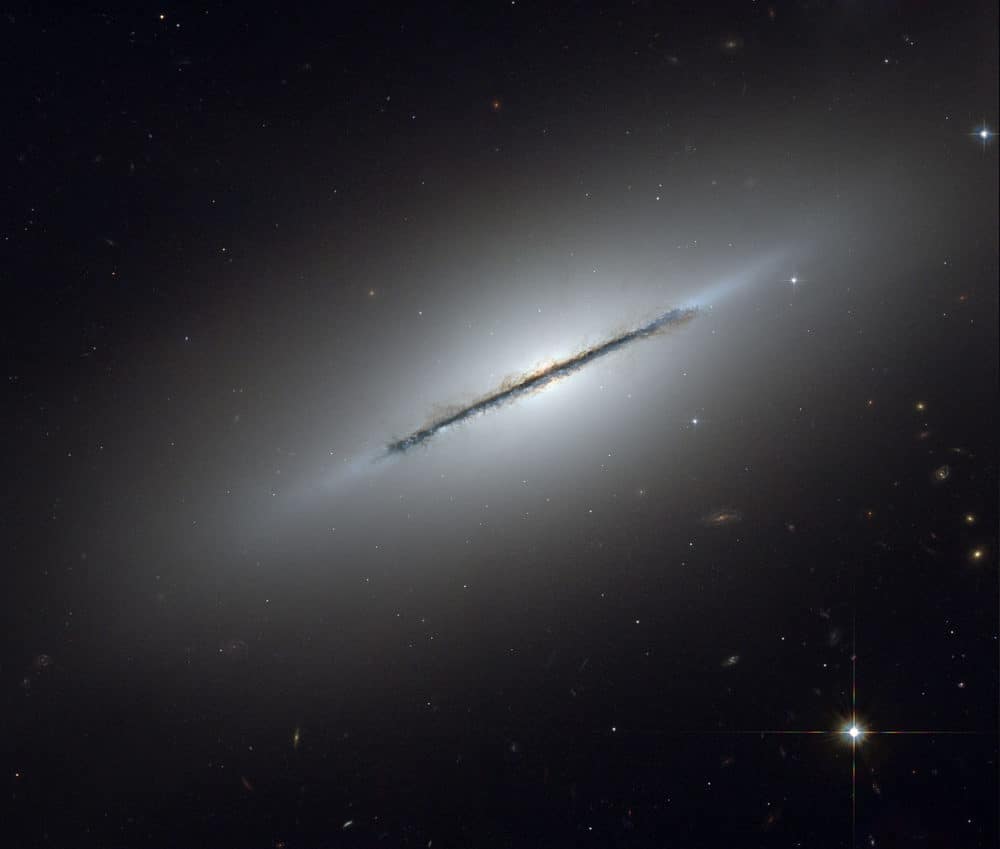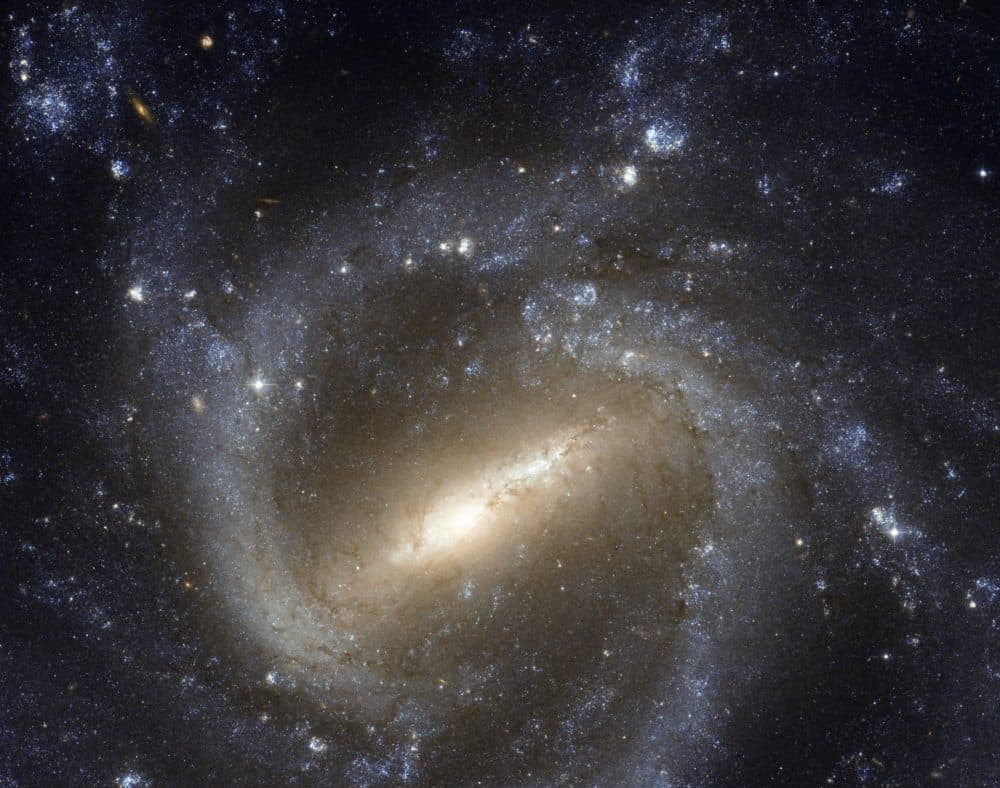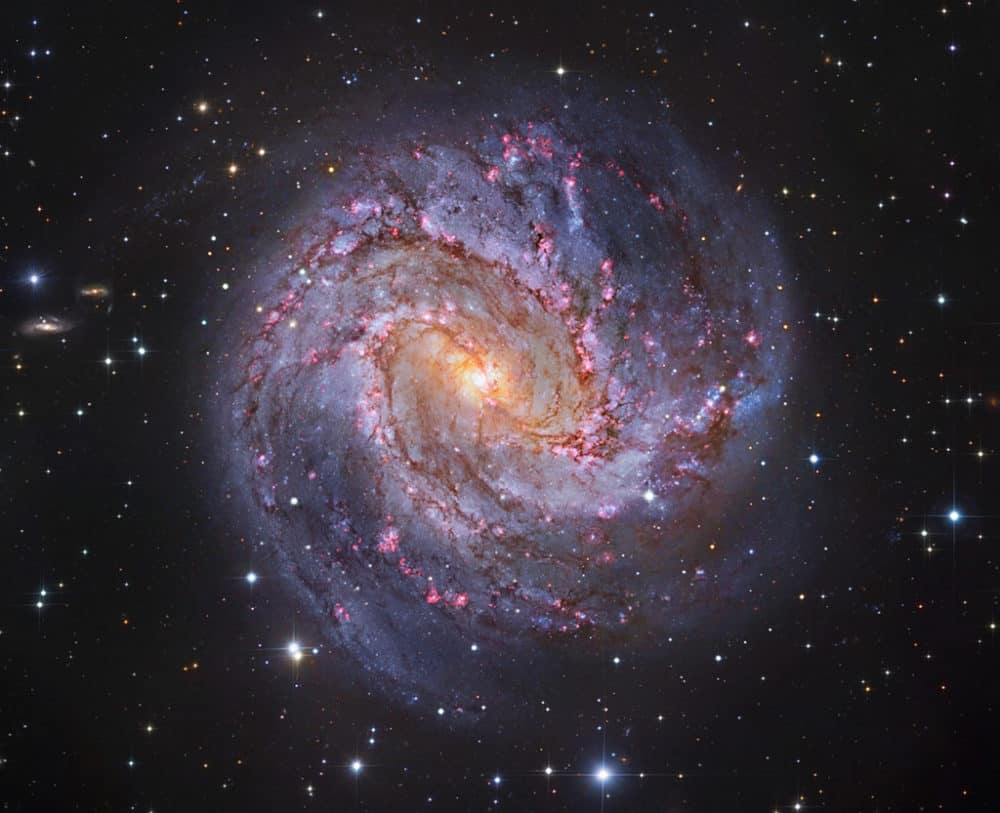Blog
An island universe containing billions of stars and situated about 40 million light-years away toward the constellation of the Dolphinfish (Dorado), NGC 1566 presents a gorgeous face-on view. Classified as a grand design spiral, NGC 1566’s shows two prominent and graceful spiral arms that are traced by bright blue star clusters and dark cosmic dust lanes. Numerous Hubble Space Telescope images of NGC 1566 have been taken to study star formation, supernovas, and the spiral’s unusually active center. Some of these images, stored online in the Hubble Legacy Archive, were freely downloaded, combined, and digitally processed by an industrious amateur to create the featured image. NGC 1566’s flaring center makes the spiral one of the closest and brightest Seyfert galaxies, likely housing a central supermassive black hole wreaking havoc on surrounding stars and gas.
more...Charles Robert Watts (born 2 June 1941) is an English drummer, best known as a member of the Rolling Stones since 1963. Originally trained as a graphic artist, he started playing drums in London’s rhythm and blues clubs, where he met Brian Jones, Mick Jagger, and Keith Richards. In January 1963, he joined their fledgling group, the Rolling Stones, as drummer, while doubling as designer of their record sleeves and tour stages. He has also toured with his own group, the Charlie Watts Quintet, and appeared in London at Ronnie Scott’s Jazz Club with the Charlie Watts Tentet.
In 2006, Watts was elected into the Modern Drummer Hall of Fame; in the same year, Vanity Fair elected him into the International Best Dressed List Hall of Fame. In the estimation of noted music critic Robert Christgau, Watts is “rock’s greatest drummer.” In 2016, he was ranked 12th on Rolling Stone‘s “100 Greatest Drummers of All Time” list.
Charles Robert “Charlie” Watts was born to Charles Richard Watts, a lorry driver for the London Midland & Scottish Railway, and his wife Lillian Charlotte (née Eaves), at University College Hospital, London, and raised (along with his sister Linda) in Kingsbury. He attended Tylers Croft Secondary Modern School from 1952 to 1956; as a schoolboy, he displayed a talent for art, cricket and football.
https://www.youtube.com/watch?v=XMr0bhvFQaY
more...Ahmad Jamal (born Frederick Russell Jones, July 2, 1930) is an American jazz pianist, composer, bandleader, and educator. For five decades, he has been one of the most successful small-group leaders in jazz.
Jamal was born in Pittsburgh, Pennsylvania. He began playing piano at the age of three, when his uncle Lawrence challenged him to duplicate what he was doing on the piano. Jamal began formal piano training at the age of seven with Mary Cardwell Dawson, whom he describes as greatly influencing him.
Trained in both traditional jazz (“American classical music”, as he prefers to call it) and European classical style, Ahmad Jamal has been praised as one of the greatest jazz innovators over his exceptionally long career. Following bebop greats like Charlie Parker and Dizzy Gillespie, Jamal entered the world of jazz at a time when speed and virtuosic improvisation were central to the success of jazz musicians as artists. Jamal, however, took steps in the direction of a new movement, later coined “cool jazz” – an effort to move jazz in the direction of popular music. He emphasized space and time in his musical compositions and interpretations instead of focusing on the blinding speed of bebop.
Because of this style, Jamal was “often dismissed by jazz writers as no more than a cocktail pianist, a player so given to fluff that his work shouldn’t be considered seriously in any artistic sense”. Stanley Crouch, author of Considering Genius, offers a very different reaction to Jamal’s music, claiming that, like the highly influential Thelonious Monk, Jamal was a true innovator of the jazz tradition and is second in importance in the development of jazz after 1945 only to Parker. His unique musical style stemmed from many individual characteristics, including his use of orchestral effects and his ability to control the beat of songs. These stylistic choices resulted in a unique and new sound for the piano trio: “Through the use of space and changes of rhythm and tempo”, writes Crouch, “Jamal invented a group sound that had all the surprise and dynamic variation of an imaginatively ordered big band.” Jamal explored the texture of riffs, timbres, and phrases rather than the quantity or speed of notes in any given improvisation. Speaking about Jamal, A. B. Spellman of the National Endowment of the Arts said: “Nobody except Thelonious Monk used space better, and nobody ever applied the artistic device of tension and release better.” These (at the time) unconventional techniques that Jamal gleaned from both traditional classical and contemporary jazz musicians helped pave the way for later jazz greats like Bill Evans, Herbie Hancock, and McCoy Tyner.
https://www.youtube.com/watch?v=is9n_QfGfto
more...Imam Mohammad Ahmad Eissa or Sheikh Imam (Arabic: إمام محمد أحمد عيسى) (July 2, 1918 – June 7, 1995) was a famous Egyptian composer and singer. For most of his life, he formed a duo with the famous Egyptian colloquial poet Ahmed Fouad Negm. Together, they were known for their political songs in favor of the poor and the working classes.
Imam was born to a poor family in the Egyptian village of Abul Numrus in Giza. He lost his sight when he was a child. At the age of five he joined a recitation class, where he memorized the Qur’an. He later moved to Cairo to study where he led a dervish life. In Cairo, Imam met Sheikh Darwish el-Hareery, a prominent musical figure at that time, who taught him the basics of music and muwashshah singing. He then worked with the Egyptian composer Zakariyya Ahmad. At that time, he expressed interest in Egyptian folk songs especially those by Sayed Darwish and Abdou el-Hamouly. He also performed at weddings and birthdays.
In 1962 he met the Egyptian poet Ahmed Fouad Negm. For many years, they formed a duo composing and singing political songs, mostly in favor of the poor oppressed classes and indicting the ruling classes. Though their songs were banned on Egyptian Radio and Television stations, they were popular among ordinary people in the 1960s and 1970s. Their revolutionary songs criticizing the government after the 1967 war led them to imprisonment and detention several times. In the mid 80s Imam performed several concerts in France, Britain, Lebanon, Tunisia, Libya and Algeria. Later Imam and Negm broke up after several disagreements. Imam died at the age of 76 after a long illness.
more...https://www.youtube.com/watch?v=Mxsq_e7idvY
more...Messier 102 (M102), also known as the Spindle Galaxy, is an edge-on lenticular galaxy located in the northern constellation Draco.
The Spindle Galaxy lies at a distance of 50 million light years from Earth and has an apparent magnitude of 10.7. It has the designation NGC 5866 in the New General Catalogue. The galaxy occupies an area of 4.7 by 1.9 arc minutes of apparent sky, corresponding to a linear extension of about 60,000 light years. It is very difficult to see with binoculars, but easily visible in small telescopes, which show a thin, nebulous patch under good conditions.
Rashied Ali, born Robert Patterson (July 1, 1933 – August 12, 2009) was an American free jazz and avant-garde drummer best known for playing with John Coltrane in the last years of Coltrane’s life.
Patterson was born and raised in Philadelphia, Pennsylvania. His family was musical; his mother sang with Jimmie Lunceford. His brother, Muhammad Ali, is also a drummer, who played with Albert Ayler. Ali, his brother, and his father converted to Islam.
Starting off as a pianist he eventually took up the drums, via trumpet and trombone. He joined the United States Army and played with military bands during the Korean War. After his military service, he returned home and studied with Philly Joe Jones.
Ali moved to New York in 1963 and worked in groups with Bill Dixon and Paul Bley. He was scheduled to be the second drummer alongside Elvin Jones on John Coltrane‘s free jazz album Ascension, but he dropped out just before the recording was to take place. Coltrane did not replace him and settled for one drummer. Ali recorded with Coltrane beginning in 1965 on the album Meditations.
Among his credits are the last recorded work by Coltrane (The Olatunji Concert) and Interstellar Space, an album of duets recorded earlier in 1967. Ali “became important in stimulating the most avant-garde kinds of jazz activities.” After Coltrane’s death, Ali performed with his widow, pianist Alice Coltrane. During the early 1970s, he ran Ali’s Alley, a loft club in New York City.
He was a visiting artist at Wesleyan University, sponsored by Clifford Thornton. He also briefly formed a non-jazz group called Purple Trap with Japanese experimental guitarist Keiji Haino and jazz-fusion bassist Bill Laswell. Their album, Decided…Already the Motionless Heart of Tranquility, Tangling the Prayer Called “I”, was released by Tzadik Records in March 1999.
more...James Henry Cotton (July 1, 1935 – March 16, 2017) was an American blues harmonica player, singer and songwriter, who performed and recorded with many of the great blues artists of his time and with his own band. He played drums early in his career but is famous for his harmonica playing.
Cotton began his professional career playing the blues harp in Howlin’ Wolf‘s band in the early 1950s. He made his first recordings in Memphis for Sun Records, under the direction of Sam Phillips. In 1955, he was recruited by Muddy Waters to come to Chicago and join his band. Cotton became Waters’s bandleader and stayed with the group until 1965. In 1965 he formed the Jimmy Cotton Blues Quartet, with Otis Spann on piano, to record between gigs with the Muddy Waters band. He eventually left to form his own full-time touring group. His first full album, on Verve Records, was produced by the guitarist Mike Bloomfield and the singer and songwriter Nick Gravenites, who later were members of the band Electric Flag.
In the 1970s, Cotton played harmonica on Muddy Waters’ Grammy Award–winning 1977 album Hard Again, produced by Johnny Winter.
Cotton was born in Tunica, Mississippi. He became interested in music when he first heard Sonny Boy Williamson II on the radio. He left home with his uncle and moved to West Helena, Arkansas, finding Williamson there. For many years Cotton claimed that he told Williamson that he was an orphan and that Williamson took him in and raised him, a story he admitted in recent years is not true. However, Williamson did mentor Cotton during his early years. Williamson left the South to live with his estranged wife in Milwaukee, Wisconsin, leaving his band in Cotton’s hands. Cotton was quoted as saying, “He just gave it to me. But I couldn’t hold it together ’cause I was too young and crazy in those days an’ everybody in the band was grown men, so much older than me.”
more...William James Dixon (July 1, 1915 – January 29, 1992) was an American blues musician, vocalist, songwriter, arranger and record producer. He was proficient in playing both the upright bass and the guitar, and sang with a distinctive voice, but he is perhaps best known as one of the most prolific songwriters of his time. Next to Muddy Waters, Dixon is recognized as the most influential person in shaping the post–World War II sound of the Chicago blues.
Dixon’s songs have been recorded by countless musicians in many genres as well as by various ensembles in which he participated. A short list of his most famous compositions includes “Hoochie Coochie Man“, “I Just Want to Make Love to You“,[5] “Little Red Rooster“, “My Babe“, “Spoonful“, and “You Can’t Judge a Book by the Cover“. These songs were written during the peak years of Chess Records, from 1950 to 1965, and were performed by Muddy Waters, Howlin’ Wolf, Little Walter, and Bo Diddley; they influenced a generation of musicians worldwide.
Dixon was an important link between the blues and rock and roll, working with Chuck Berry and Bo Diddley in the late 1950s. His songs have been covered by some of the most successful musicians of the past sixty years including Bob Dylan and Jimi Hendrix. Jeff Beck, Cream, The Doors, Led Zeppelin, The Rolling Stones and Steppenwolf all featured at least one of his songs on their debut albums, a measure of his influence on rock music.
He received a Grammy Award and was inducted into the Blues Hall of Fame, the Rock and Roll Hall of Fame, and the Songwriters Hall of Fame.
Dixon was born in Vicksburg, Mississippi, on July 1, 1915. He was one of fourteen children.His mother, Daisy, often rhymed things she said, a habit her son imitated. At the age of seven, young Dixon became an admirer of a band that featured pianist Little Brother Montgomery. He sang his first song at Springfield Baptist Church at the age of four Dixon was first introduced to blues when he served time on prison farms in Mississippi as a young teenager. Later in his teens, he learned how to sing harmony from a local carpenter, Theo Phelps, who led a gospel quintet, the Union Jubilee Singers, in which Dixon sang bass; the group regularly performed on the Vicksburg radio station WQBC. He began adapting his poems into songs and even sold some to local music groups.
more...NGC 1073 is a barred spiral galaxy in the constellation Cetus. It probably has an H II nucleus. NGC 1073 is about 55 million light years from Earth. NGC 1073 is about 80,000 light years across. NGC 1073 can be viewed with a mid-sized telescope and is found in the Cetus constellation, also called the Sea Monster. NGC 1073 is a barred spiral galaxy like the Milky Way; unlike the Milky Way, however, NGC 1073 does not have well formed symmetrical arms and the center bar is larger.
more...Matthew Paul Miller (born June 30, 1979), known by his Hebrew and stage name Matisyahu (/ˌmɑːtɪsˈjɑːhuː/; מתּתיהו, “Gift of Yahu) (the Hebrew name of God)”), is an American Jewish reggae singer, rapper, beatboxer, and alternative rock musician.
Known for blending Orthodox Jewish themes with reggae, rock and hip hop beatboxing sounds, Matisyahu’s 2005 single “King Without a Crown” was a Top 40 hit in the United States. Since 2004, he has released five studio albums as well as two live albums, two remix CDs and two DVDs featuring live concerts. In addition, Matisyahu played the role of Tzadok in The Possession, a supernatural horror film directed by Ole Bornedal and co-produced by Sam Raimi. Through his career, Matisyahu has worked with Bill Laswell, reggae producers Sly & Robbie, and Kool Kojak.
Matthew Paul Miller was born on June 30, 1979, in West Chester, Pennsylvania. His family eventually settled in White Plains, New York. He was brought up a Reconstructionist Jew, and attended Hebrew school at Bet Am Shalom, a synagogue in White Plains. He spent much of his childhood learning the tenets of Judaism, but by the time he was a teenager, Matisyahu began to rebel against his rigid upbringing. He started taking drugs and dropped out of White Plains Senior High School. He became a self-professed “Phish-head”, taking hallucinogens and following the rock band Phish on tour.
more...Stanley Clarke (born June 30, 1951) is an American bassist and founding member of Return to Forever, one of the first jazz fusion bands. He has composed music for films and television and has worked with musicians in many genres. Like Jaco Pastorius, Clarke gave the bass guitar a prominence it lacked in jazz-related music.
Clarke was born in Philadelphia. His mother sang opera around the house, belonged to a church choir, and encouraged him to study music. He started on accordion, then tried violin. But he felt awkward holding such a small instrument in his big hands when he was twelve years old and over six feet tall. No one wanted the acoustic bass in the corner, so he picked it up. He took lessons on double bass at the Settlement Music School in Philadelphia, beginning with five years of classical music. He picked up bass guitar in his teens so that he could perform at parties and imitate the rock and pop bands that girls liked.
Clarke attended the Philadelphia Musical Academy (later known as the Philadelphia College of the Performing Arts, and ultimately as the University of the Arts, after a merge with the Philadelphia College of Art) and after graduating moved to New York City in 1971. His recording debut was with Curtis Fuller. He worked with Joe Henderson and Pharoah Sanders, then in 1972 with Stan Getz, Dexter Gordon, and Art Blakey, followed by Gil Evans, Mel Lewis, and Horace Silver.
Clarke intended to become the first black musician in the Philadelphia Orchestra until he met jazz pianist Chick Corea. In 1973, he and Corea founded the band Return to Forever. The first edition of Return to Forever performed primarily Latin-oriented music. This band consisted of singer Flora Purim, her husband Airto Moreira (both Brazilians) on drums and percussion, Corea’s longtime musical co-worker Joe Farrell on saxophone and flute, and Clarke on bass. Their first album, titled Return to Forever, was recorded for ECM Records in 1972. Their second album, Light as a Feather (1973), was released by Polydor and included the song “Spain“.
more...Apostolos Nikolaidis (Greek: Απόστολος Νικολαΐδης) (30 June 1938 – 22 April 1999) was a Greek singer whose career spanned four decades. He was born in Drama, Greece and grew up in Thessaloniki. He is best known for being the first Greek artist to record or re-record the authentic, “prohibited” rebetika songs in the early 1970s with their original lyrics at a time when this type of music was censored in Greece due to the military junta of 1967–1974 in power.
As a young child, Apostolos sang the popular songs he heard on the radio and whatever songs his mother, a seamstress, taught him. Although his affinity for singing was obvious from a very young age, upon completing grade school in 1951, he went to work with his father in construction, singing songs to himself or for anyone who would listen while picking up nails or carrying cement on construction sites.
It was when Apostolos heard songs on the radio sung by Stelios Kazantzidis, a performer he admired greatly, that he realized his calling. Much to his parents’ chagrin, he bought a guitar, formed a trio and started to sing around the neighborhood. The youngsters sang the well-known songs of the time, mostly hits performed by popular artists like Kazantzidis and Grigoris Bithikotsis.
more...Andrew Hill (June 30, 1931– April 20, 2007) was an American jazz pianist and composer.
Jazz critic John Fordham described Hill as a “uniquely gifted composer, pianist and educator” although “his status remained largely inside knowledge in the jazz world for most of his career.”
Hill recorded for Blue Note Records for nearly a decade, producing a dozen albums. Andrew Hill was born in Chicago, Illinois (not in Port-au-Prince, Haiti, nor was he born in 1937, as was reported by many earlier jazz reference books), to William and Hattie Hille. He had a brother, Robert, who was a singer and classical violin player. Hill took up the piano at the age of thirteen, and was encouraged by Earl Hines. As a child, he attended the University of Chicago Experimental School. He was referred by jazz composer Bill Russoto Paul Hindemith, with whom he studied informally until 1952.
Spiral galaxy M83 lies a mere twelve million light-years away, near the southeastern tip of the very long constellation Hydra. Prominent spiral arms traced by dark dust lanes and blue star clusters lend this galaxy its popular name, The Southern Pinwheel. But reddish star forming regions that dot the sweeping arms highlighted in this sparkling color composite also suggest another nickname, The Thousand-Ruby Galaxy. About 40,000 light-years across, M83 is a member of a group of galaxies that includes active galaxy Centaurus A. In fact, the core of M83 itself is bright at x-ray energies, showing a high concentration of neutron stars and black holes left from an intense burst of star formation. This sharp composite color image also features spiky foreground Milky Way stars and distant background galaxies. The image data was taken from the Subaru Telescope, the European Southern Observatory’s Wide Field Imager camera, and the Hubble Legacy Archive.
more...More Posts
- Music for Surviving the Pandemic and Realizing Racial Justice
- The Cosmos with NGC 7513
- Bela Fleck Day
- Arlo Guthrie Day
- Hank Mobley Day
- Blind Boy Fuller Day
- Flamenco Fridays with Jesús de Madrid y Pepe de Almería
- Daily Roots with Coco Tea
- Music for Surviving the Pandemic and Realizing Racial Justice
- The Cosmos with NGC 2775
- Mitch Mitchell Day
- Mercedes Sosa Day
- Frank Wright Day
- Joe Liggins Day
- World Music with Santrofi
- Daily Roots with Sanchez
- Music for Surviving the Pandemic and Realizing Racial Justice
- The Cosmos with Comet C/2019 U6
- Jaimoe Day
- Johnnie Johnson Day




